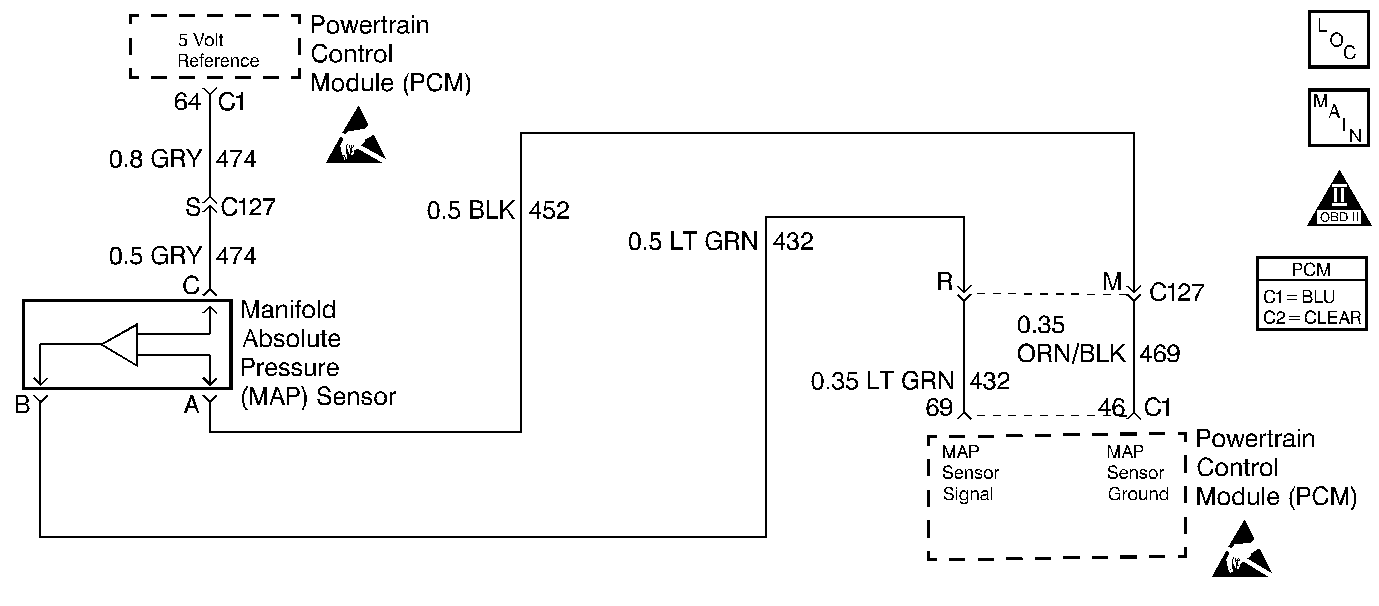
Circuit Description
The Manifold Absolute Pressure sensor is a sensor that changes resistance based upon manifold vacuum. The PCM provides a 5 volt reference and ground. The MAP sensor signal varies between ground and 5 volts as manifold vacuum varies. As MAP decreases, voltage decreases (low engine load, high vacuum). As MAP increases, voltage increases (high engine load, low vacuum). The PCM uses the MAP sensor values as an indicator of engine load. A short to ground or open condition would cause the MAP sensor signal to go low, setting DTC P0107.
Conditions for Setting the DTC
Test Conditions
| • | DTCs P0122 and P0123 not set. |
| • | Engine speed 700 RPM or less. |
| • | TP sensor 18 degrees or less. |
OR
| • | DTCs P0122 and P0123 not set. |
| • | Engine speed 1800 RPM or less. |
| • | TP sensor 13 degrees or greater. |
| • | Transaxle not in PARK or NEUTRAL. |
Failure Condition
The MAP sensor reading has been 0.08 volts or less.
Action Taken When the DTC Sets
| • | PCM turns ON the SERVICE EMISSION SYSTEM message. |
| • | PCM disables long term fuel trim. |
| • | PCM uses a substitute MAP value based on engine RPM and throttle angle. |
| • | PCM uses 92.2 kPa for barometric pressure. |
| • | PCM disables Evaporative Emission (EVAP) control solenoid. |
| • | PCM disables torque management. |
| • | Transaxle shift adapts are maintained at current levels. |
| • | The PCM will illuminate the malfunction indicator lamp (MIL) when the diagnostic runs and fails. |
| • | The PCM will record operating conditions at the time the diagnostic fails. This information will be stored in the Freeze Frame and Failure Records. |
Conditions for Clearing the MIL/DTC
| • | The PCM will turn the MIL OFF after three consecutive drive trips that the diagnostic runs and does not fail. |
| • | A Last Test Failed (current) DTC will clear when the diagnostic runs and does not fail. |
| • | A History DTC will clear after forty consecutive warm-up cycles with no failures of any emission related diagnostic test. |
| • | Use a scan tool to clear DTCs. |
| • | Interrupting PCM battery voltage may or may not clear DTCs. This practice is not recommended. Refer to Clearing Diagnostic Trouble Codes in PCM Description and Operation. |
Test Description
Number(s) below refer to the step number(s) on the Diagnostic Table.
-
If the MAP sensor or circuitry are open, the MAP sensor parameter will read 10-16 kPa.
-
Checking if circuitry from the sensor to the PCM is able to respond to a 5 volt signal on MAP input. A reading of 103-105 means wiring and PCM are OK.
Step | Action | Value(s) | Yes | No |
|---|---|---|---|---|
1 | Was the Powertrain On-Board Diagnostic (OBD) System Check performed? | -- | Go to A Powertrain On Board Diagnostic (OBD) System Check | |
Is the value displayed the same or less than the value specified? | 17 kPa | Fault not present. Go to DTC P0106 Manifold Absolute Pressure (MAP) System Performance | ||
Is the value displayed higher than the value specified? | 102 kPa | |||
4 |
Is the voltage the same or higher than the voltage specified? | 4.5 volts | ||
5 |
Is either resistance less than the value specified? | 10K ohms | ||
6 | Measure the resistance between PCM connector C1 terminal 69 and MAP sensor connector terminal B (harness side). Is the resistance more than the value specified? | 5 ohms | ||
7 |
Is the voltage higher than the value specified? | 0.1 volts | ||
8 |
Is the resistance more than the value specified? | 5 ohms | ||
9 |
Is the resistance less than the value specified? | 10K ohms | ||
10 | Repair the short to ground in the MAP Sensor Signal circuit or the signal circuit shorted to the ground circuit. Is the repair complete? | -- | Go to Powertrain Control Module Diagnosis for Verify Repair | -- |
11 | Repair the open in the MAP Sensor Signal circuit. Is the repair complete? | -- | Go to Powertrain Control Module Diagnosis for Verify Repair | -- |
12 | Repair the open in the 5 Volt Reference circuit. Is the repair complete? | -- | Go to Powertrain Control Module Diagnosis for Verify Repair | -- |
13 | Repair short to ground in CKT(s) with low resistance. Is the repair complete? | -- | Go to Powertrain Control Module Diagnosis for Verify Repair | -- |
14 |
Was terminal contact repaired? | -- | Go to Powertrain Control Module Diagnosis for Verify Repair | |
15 | Replace the MAP sensor. Refer to MAP Sensor Replacement replacement. Is the replacement complete? | -- | Go to Powertrain Control Module Diagnosis for Verify Repair | -- |
16 |
Was terminal contact repaired? | -- | Go to Powertrain Control Module Diagnosis for Verify Repair | |
17 | Replace the PCM. Refer to PCM Replacement/Programming . Is the replacement complete? | -- | Go to Powertrain Control Module Diagnosis for Verify Repair | -- |
